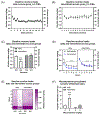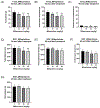Mifepristone decreases nicotine intake in dependent and non-dependent adult rats
- PMID: 38332661
- PMCID: PMC11061865
- DOI: 10.1177/02698811241230255
Mifepristone decreases nicotine intake in dependent and non-dependent adult rats
Abstract
Background: Addiction to tobacco and nicotine products has adverse health effects and afflicts more than a billion people worldwide. Therefore, there is an urgent need for new treatments to reduce tobacco and nicotine use. Glucocorticoid receptor blockade shows promise as a novel treatment for drug abuse and stress-related disorders.
Aim: These studies aim to investigate whether glucocorticoid receptor blockade with mifepristone diminishes the reinforcing properties of nicotine in rats with intermittent or daily long access to nicotine.
Methods: The rats self-administered 0.06 mg/kg/inf of nicotine for 6 h per day, with either intermittent or daily access for 4 weeks before treatment with mifepristone. Daily nicotine self-administration models regular smoking, while intermittent nicotine self-administration models occasional smoking. To determine whether the rats were dependent, they were treated with the nicotinic acetylcholine receptor antagonist mecamylamine, and somatic signs were recorded.
Results: The rats with intermittent access to nicotine had a higher level of nicotine intake per session than those with daily access but only the rats with daily access to nicotine showed signs of physical dependence. Furthermore, mecamylamine increased nicotine intake during the first hour of access in rats with daily access but not in those with intermittent access. Mifepristone decreased total nicotine intake in rats with intermittent and daily access to nicotine. Moreover, mifepristone decreased the distance traveled and rearing in the open field test and operant responding for food pellets.
Conclusion: These findings indicate that mifepristone decreases nicotine intake but this effect may be partially attributed to the sedative effects of mifepristone.
Keywords: Smoking; glucocorticoid receptors; mecamylamine; mifepristone; nicotine; rats.
Conflict of interest statement
Declaration of conflicting interestsThe author(s) declared no potential conflicts of interest with respect to the research, authorship, and/or publication of this article.
Figures






Similar articles
-
Prolonged nicotine dependence associated with extended access to nicotine self-administration in rats.Psychopharmacology (Berl). 2004 Apr;173(1-2):64-72. doi: 10.1007/s00213-003-1692-7. Epub 2004 Jan 8. Psychopharmacology (Berl). 2004. PMID: 14712336
-
Relationship Between Nicotine Intake and Reward Function in Rats With Intermittent Short Versus Long Access to Nicotine.Nicotine Tob Res. 2020 Feb 6;22(2):213-223. doi: 10.1093/ntr/ntz052. Nicotine Tob Res. 2020. PMID: 30958557 Free PMC article.
-
The role of glucocorticoid and nicotinic acetylcholine receptors in the reward-enhancing effects of nicotine in the ICSS procedure in male and female rats.Drug Alcohol Depend. 2025 Feb 1;267:112531. doi: 10.1016/j.drugalcdep.2024.112531. Epub 2024 Dec 20. Drug Alcohol Depend. 2025. PMID: 39752924
-
'Nicotine deprivation effect' in rats with intermittent 23-hour access to intravenous nicotine self-administration.Pharmacol Biochem Behav. 2007 Feb;86(2):346-53. doi: 10.1016/j.pbb.2007.01.004. Epub 2007 Jan 13. Pharmacol Biochem Behav. 2007. PMID: 17292952 Free PMC article.
-
Development of Dependence in Smokers and Rodents With Voluntary Nicotine Intake: Similarities and Differences.Nicotine Tob Res. 2023 Jun 9;25(7):1229-1240. doi: 10.1093/ntr/ntac280. Nicotine Tob Res. 2023. PMID: 36482774 Free PMC article. Review.
Cited by
-
Sex differences in nicotine intake and relapse behavior in nicotine-dependent adult wistar rats.Front Pharmacol. 2024 Sep 26;15:1415219. doi: 10.3389/fphar.2024.1415219. eCollection 2024. Front Pharmacol. 2024. PMID: 39391691 Free PMC article.
-
Persistent Anhedonia After Intermittent Long-Access Nicotine Self-Administration in Rats.bioRxiv [Preprint]. 2025 Mar 19:2025.03.19.644137. doi: 10.1101/2025.03.19.644137. bioRxiv. 2025. PMID: 40166193 Free PMC article. Preprint.
References
-
- Ahmed SH and Koob GF (1999) Long-lasting increase in the set point for cocaine self-administration after escalation in rats. Psychopharmacology (Berl) 146(3): 303–312. - PubMed
-
- Ambrose JA and Barua RS (2004) The pathophysiology of cigarette smoking and cardiovascular disease: an update. Journal of the American college of cardiology 43(10): 1731–1737. - PubMed
-
- American Psychiatric Association (2013) Diagnostic and statistical manual of mental health disorders, fifth edition (DSM-5). Washington, DC: American Psychiatric Publishing.
-
- Barr AM, Brotto LA and Phillips AG (2000) Chronic corticosterone enhances the rewarding effect of hypothalamic self-stimulation in rats. Brain Res. 875(1-2): 196–201. - PubMed
Publication types
MeSH terms
Substances
Grants and funding
LinkOut - more resources
Full Text Sources

